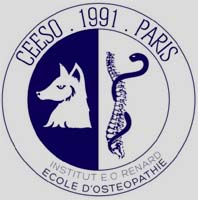La reproductibilité inter-praticien de deux tests ostéopathiques sur le rachis lombaire
Test en décubitus latéral et spring test
GOUTIERREZ Alexis

Mémoire en vue de l’obtention d’un diplôme d’ostéopathe - Centre Européen d’Enseignement Supérieur en Ostéopathie — CEESO 2016 - Tuteur : ALLONCLE Nicolas, ostéopathe D.O - 15 Février 2016
Le Site de l’Ostéopathie remercie le Directeur du CEESO Paris de l’avoir autorisé à présenter ce mémoire
Résumé
Introduction : Évaluer et comparer la reproductibilité inter-praticien de deux tests ostéopathiques sur le rachis lombaire (spring test et dest de mobilité en décubitus latéral) et observer la capacité de deux jeunes ostéopathes à objectiver une dysfonction somatique.
Matériel et méthode : Les sujets (N=60), recrutés au sein du CEESO, ont été séparés en deux groupe distincts (N=30). Les deux praticiens ont réalisé, à tour de rôle, le test spring test sur tous les patients du premier groupe, et le test de mobilité en décubitus latéral sur tous les patients du second groupe. Les dysfonctions somatiques retrouvées n’était pas communiquées entre les praticiens. Les résultats ont été soumis au calcul de kappa cohen afin de mesurer leur concordance.
Résultats : Le spring test nous a donné un K=0,49 soit une concordance moyenne inter-praticien contre un K=0,28 pour le test en décubitus latéral, soit une concordance faible inter praticien. Les deux praticiens ont retrouvés la même zone dysfonctionnelle (+/- un étage) dans 87% pour le spring test et dans 80% pour le test en décubitus latéral.
Conclusion : Le spring test possède une meilleure reproductibilité inter-praticien. Deux jeunes ostéopathes ont retrouvés dans 80 et 87% des cas la même zone dysfonctionnelle.
Mots-clés : Reproductibilité inter-praticien, Spring test, Test de mobilité, Lombaires, Ostéopathie
Abstract
Introduction : Evaluate and compare the inter-practitioner replication of two osteopathic tests on the lumbar rachis (spring test and mobility test of the lateral decubitus position) and observe the capacity of two young osteopaths to objectify a somatic dysfunction.
Material and method : The subjects (N=60), recruited amongst the CEESO, have been separated in distinct groups (N=30). The two practitioners have realized, alternately, the spring test on all the patients of the first group, and the lateral decubitus mobility test on all the patients of the second group. The somatic dysfunctions that were found were not communicated between practitioners. The results were submitted to the kappa cohen calculation in order to measure their accordance.
Results : the spring test resulted in a K=0,49, either an average inter-practitioner accordance against a K=0,28 for the lateral decubitus mobility test, either a weak inter-practitioner accordance. The two practitioners have found the same dysfunctional zone (+/- one floor) in 87% for the spring test and in 80% in the lateral decubitus mobility test.
Conclusion : the spring test possesses better inter-practitioner replication. Two young osteopaths have found that in 80 and 87% of cases in the same dysfunctional zone.
Keywords : Inter-practitioner replication, Spring test, Mobility test of the lateral decubitus position, Lumbar, Osteopathic



